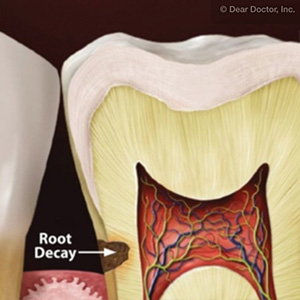Tooth decay is one of two dental diseases most responsible for tooth loss (gum disease being the other). In the absence of treatment, what starts as a hole or cavity in a tooth’s outer layers can steadily advance toward its interior.
Most people associate cavities with the crown, the part of a tooth you can see. But cavities can also occur in a tooth’s roots, especially with older adults. Root cavities pose two distinct difficulties: They can lead to more rapid decay spread than crown cavities within a tooth; and they’re harder to detect.
Tooth roots are ordinarily covered by the gums, which protects them from bacterial plaque, the main cause for decay. But roots can become exposed due to receding gums, a common problem with seniors who are more susceptible to gum disease.
Unlike the enamel-covered crowns, tooth roots depend on gum coverage for protection against bacteria and the acid they produce. Without this coverage, the only thing standing between tooth decay and the roots is a thin material called cementum.
If decay does enter a tooth’s interior, saving it often requires a root canal treatment to remove decayed tissue in the inner pulp and root canals, and then replacing it with a filling. But if we’re able to discover a root cavity in its early stages, we may be able to fill it like a crown cavity.
The best strategy, though, is to prevent root cavities from forming. This starts with a dedicated daily regimen of brushing and flossing to remove dental plaque. If you’re at high risk for root cavities, we may also recommend antibacterial mouthrinses and other aids.
Regular dental visits are also a must: a minimum of twice-a-year dental cleanings to remove stubborn plaque and calculus (hardened plaque) deposits. For added protection against root cavities, we can also apply fluoride varnish to strengthen teeth. And regular visits are the best way to detect any cavity in its early stages when treatment is less invasive.
A heightened risk of dental problems like root cavities are a part of the aging process. But partnering together, we can lower that risk and increase the longevity of your teeth.
If you would like more information on root cavities, please contact us or schedule an appointment for a consultation. You can also learn more about this topic by reading the Dear Doctor magazine article “Root Cavities.”




